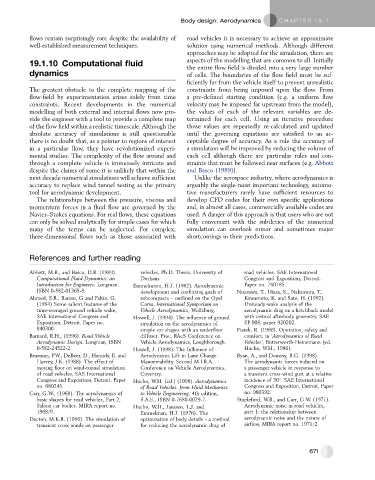Page 661 - Automotive Engineering Powertrain Chassis System and Vehicle Body
P. 661
Body design: Aerodynamics C HAPTER 19.1
flows remain surprisingly rare despite the availability of road vehicles it is necessary to achieve an approximate
well-established measurement techniques. solution using numerical methods. Although different
approaches may be adopted for the simulation, there are
aspects of the modelling that are common to all. Initially
19.1.10 Computational fluid
the entire flow field is divided into a very large number
dynamics of cells. The boundaries of the flow field must be suf-
ficiently far from the vehicle itself to prevent unrealistic
The greatest obstacle to the complete mapping of the constraints from being imposed upon the flow. From
flow-field by experimentation arises solely from time a pre-defined starting condition (e.g. a uniform flow
constraints. Recent developments in the numerical velocity may be imposed far upstream from the model),
modelling of both external and internal flows now pro- the values of each of the relevant variables are de-
vide the engineer with a tool to provide a complete map termined for each cell. Using an iterative procedure
of the flow field within a realistic timescale. Although the those values are repeatedly re-calculated and updated
absolute accuracy of simulations is still questionable until the governing equations are satisfied to an ac-
there is no doubt that, as a pointer to regions of interest ceptable degree of accuracy. As a rule the accuracy of
in a particular flow, they have revolutionized experi- a simulation will be improved by reducing the volume of
mental studies. The complexity of the flow around and each cell although there are particular rules and con-
through a complete vehicle is immensely intricate and straints that must be followed near surfaces (e.g. Abbott
despite the claims of some it is unlikely that within the and Basco (1989)).
next decade numerical simulations will achieve sufficient Unlike the aerospace industry, where aerodynamics is
accuracy to replace wind tunnel testing as the primary arguably the single-most important technology, automo-
tool for aerodynamic development. tive manufacturers rarely have sufficient resources to
The relationships between the pressure, viscous and develop CFD codes for their own specific applications
momentum forces in a fluid flow are governed by the and, in almost all cases, commercially available codes are
Navier–Stokes equations. For real flows, these equations used. A danger of this approach is that users who are not
can only be solved analytically for simple cases for which fully conversant with the subtleties of the numerical
many of the terms can be neglected. For complex, simulation can overlook minor and sometimes major
three-dimensional flows such as those associated with shortcomings in their predictions.
References and further reading
Abbott, M.B., and Basco, D.R. (1989). vehicles, Ph.D. Thesis, University of road vehicles. SAE International
Computational Fluid Dynamics: an Durham. Congress and Exposition, Detroit.
Introduction for Engineers. Longman. Emmelmann, H-J. (1982). Aerodynamic Paper no. 760185.
ISBN 0-582-01365-8. development and conflicting goals of Nouzawa, T., Hiasa, K., Nakamura, T.,
Ahmed, S.R., Ramm, G and Faltin, G. subcompacts – outlined on the Opel Kawamoto, K. and Sato, H. (1992).
(1984) Some salient features of the Corsa. International Symposium on Unsteady-wake analysis of the
time-averaged ground vehicle wake, Vehicle Aerodynamics, Wolfsburg. aerodynamic drag on a hatchback model
SAE International Congress and Howell, J. (1994). The influence of ground with critical afterbody geometry. SAE
Exposition, Detroit. Paper no. simulation on the aerodynamics of SP-908, paper 920202.
840300. simple car shapes with an underfloor Piatek, R. (1986). Operation, safety and
Barnard, R.H., (1996). Road Vehicle diffuser. Proc. RAeS Conference on comfort: in ‘Aerodynamics of Road
Aerodynamic Design. Longman, ISBN Vehicle Aerodynamics, Loughborough. Vehicles’, Butterworth-Heinemann (ed.
0-582-24522-2. Howell, J. (1998). The Influence of Hucho, W.H., 1986).
Bearman, P.W., DeBeer, D., Hamidy, E. and Aerodynamic Lift in Lane Change Ryan, A., and Dominy, R.G. (1998).
Harvey, J.K. (1988). The effect of Manoevrability. Second M.I.R.A. The aerodynamic forces induced on
moving floor on wind-tunnel simulation Conference on Vehicle Aerodynamics, a passenger vehicle in response to
of road vehicles, SAE International Coventry. a transient cross-wind gust at a relative
Congress and Exposition, Detroit. Paper Hucho, W.H. (ed.) (1998). Aerodynamics incidence of 30 . SAE International
no. 880245. of Road Vehicles: from Fluid Mechanics Congress and Exposition, Detroit. Paper
Carr, G.W., (1968). The aerodynamics of to Vehicle Engineering, 4th edition, no. 980392.
basic shapes for road vehicles, Part 2, S.A.E., ISBN 0-7680-0029-7. Stapleford, W.R., and Carr, G.W. (1971).
Saloon car bodies. MIRA report no. Hucho, W.H., Janssen, L.J. and Aerodynamic noise in road vehicles,
1968/9. Emmelman, H.J. (1976). The part 1: the relationship between
Docton, M.K.R. (1996). The simulation of optimization of body details – a method aerodynamic noise and the nature of
transient cross winds on passenger for reducing the aerodynamic drag of airflow, MIRA report no. 1971/2.
671

